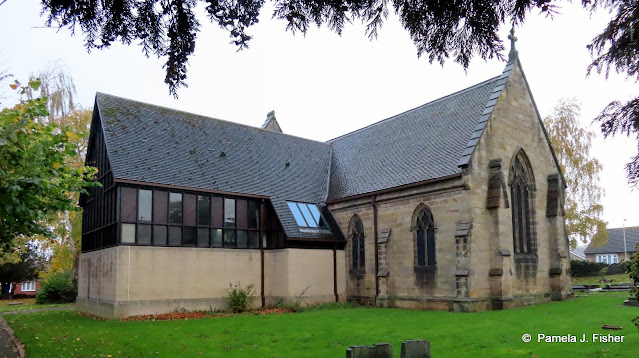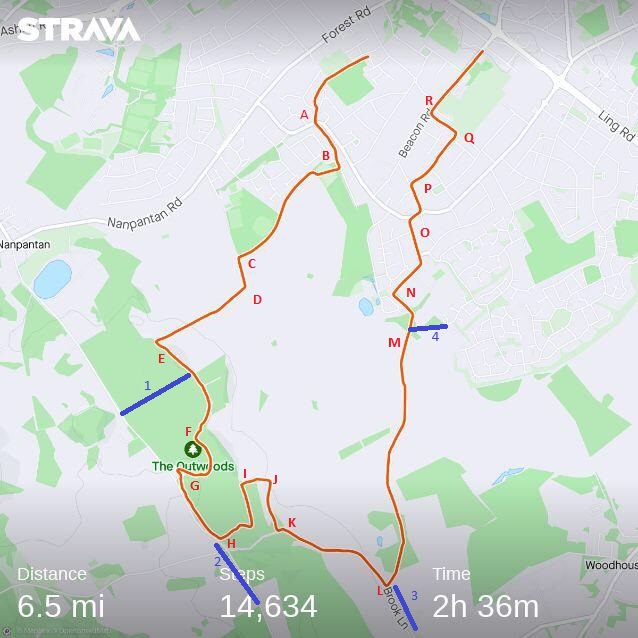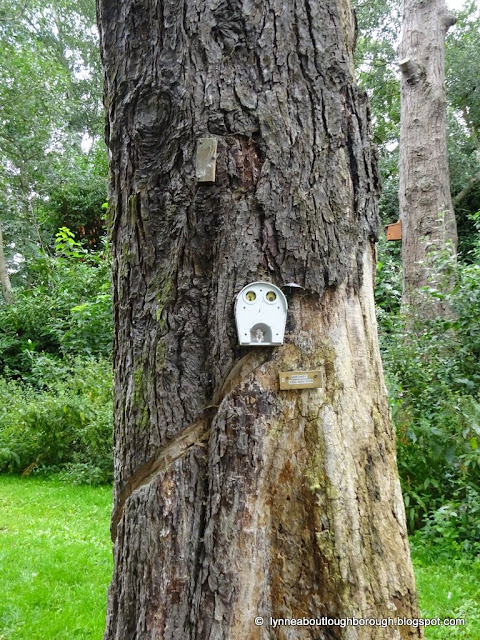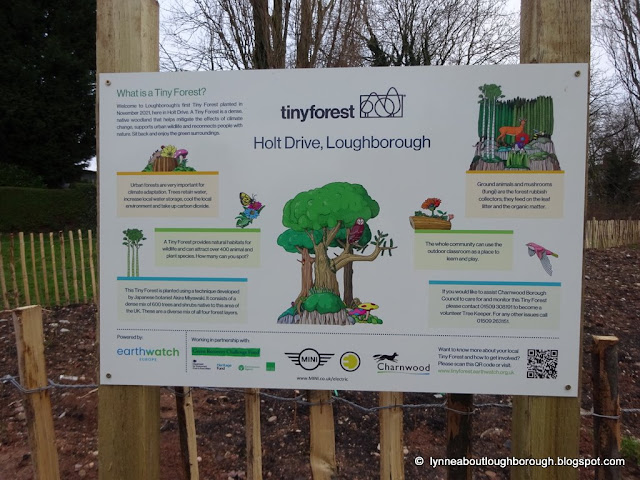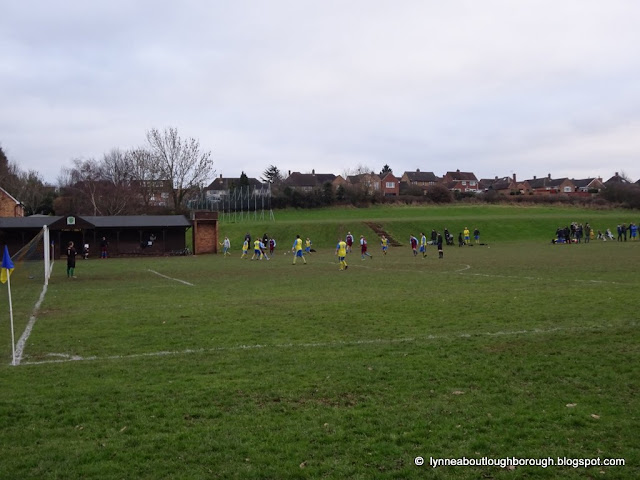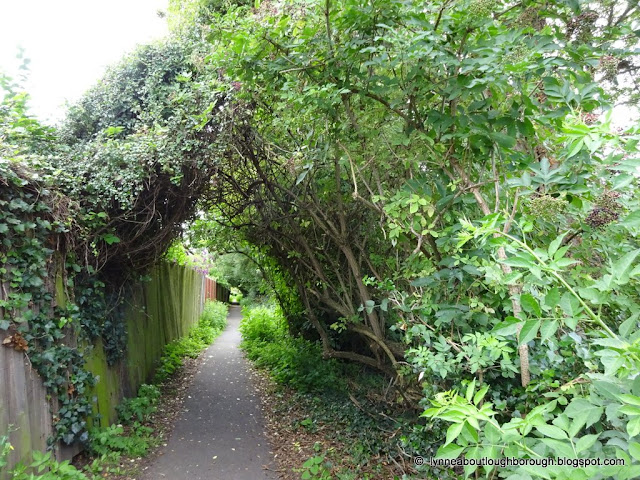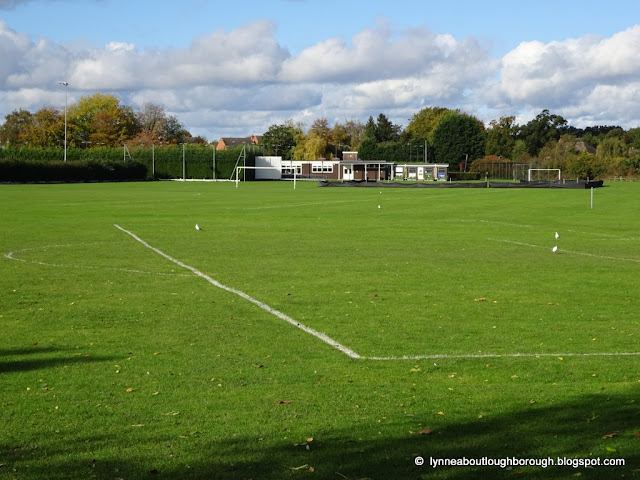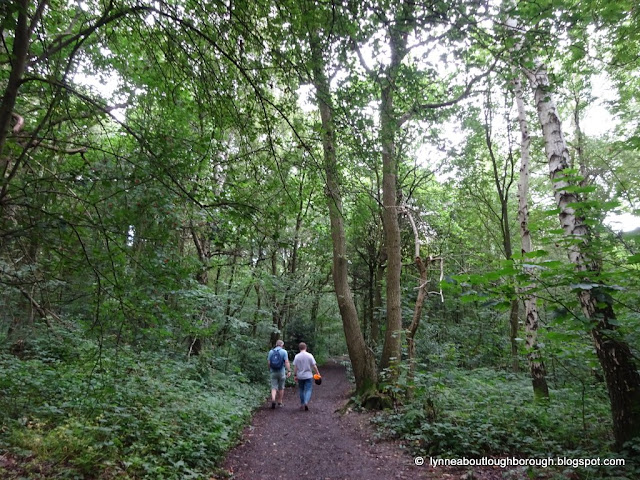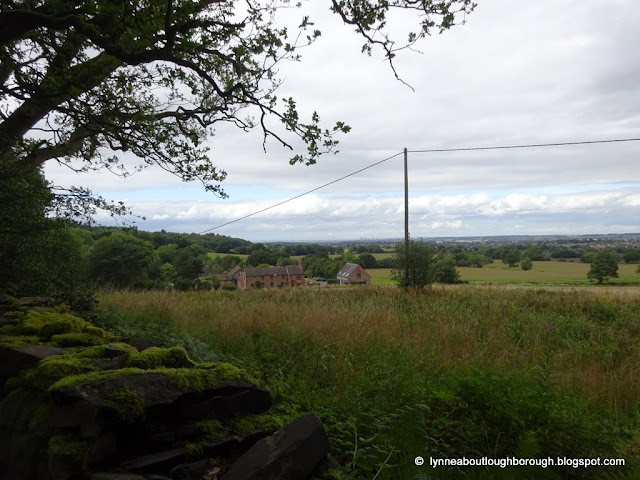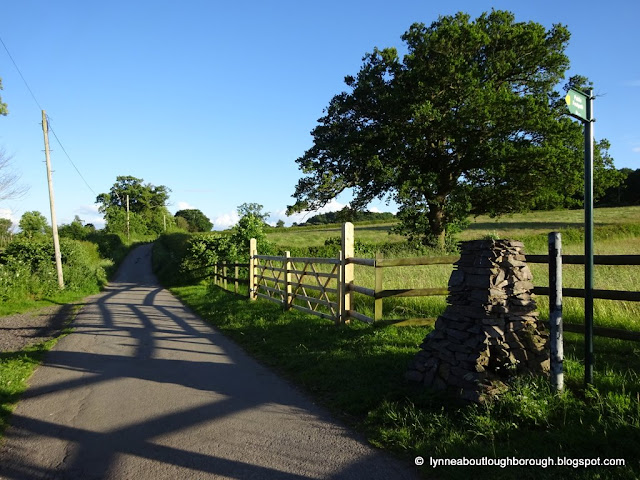I remember turning out one cold and wet winter evening in 2016 to attend a book launch at Donnington Hall for a Victoria County History Book about Castle Donnington! It was a lovely event, and the authors each gave a short speech. One of those authors was Pam, which was how I came to meet her. Since then, it won't surprise you to know that our paths have frequently crossed at heritage events and talks, and we often find our areas of interest and research overlap! In her guest post, which is the last article in a series specifically celebrating the 10th anniversary of the blog, Pam tells us the story of Mary Tate, a notable inhabitant of Burleigh Hall. Read on to find out why ...
Mary Tate
By Pamela J.
Fisher
Writing to the Ecclesiastical Commissioners in 1849 about the new church and benefice of Thorpe Acre, the Bishop of Peterborough wrote of Miss Mary Tate: ‘Her exertions, to use the expression in the neighbourhood, hav[e] been the very “making of the place”’. It was not just Thorpe Acre that benefited from her ‘exertions’: Mary Tate also provided two schools in Loughborough, assisted a third, made a substantial contribution towards the cost of building Emmanuel Church, provided food for the poor of Loughborough and left money in her will to Loughborough Dispensary.
Mary was the life tenant of her family property, Burleigh Hall, a country house in substantial grounds, the site of which now forms part of Loughborough University campus. She was born on 20 December 1775 and was the only child of George Tate and his wife Bridget Moore (née Ford), who had married on 9 March that year in St George’s church, Hanover Square in the city of Westminster. George was of that parish and Bridget was from the parish of St James, Westminster. Mary was baptised at St George’s church, Hanover Square on 14 February 1776.
Members of the Tate family had been at Burleigh since at least 1705. Mary inherited her life interest from her father in 1822, but she was not a direct descendant of ‘Henry Tate of Burleigh’, the owner of the Hall and Park who had died in 1722. A hint of her family’s extensive landholdings is given in the parish register of Mitcham, Surrey when her father was buried there on 25 May 1822, aged 76: ‘George Tate Esq from Southampton, Hants, of Burleigh House near Loughborough’. The mention of Southampton is a reference to another family property, Langdown House in Dibden and Hythe, near Southampton Water, which is believed to have been built for George in 1797. It was demolished in the 1960s, but a painting shows a substantial property standing in large landscaped grounds.
George also owned at least one property in London and another in Mitcham, and the latter place was clearly dear to the family, as both George and Mary in their wills asked to be buried at Mitcham, where there was a family vault. Mary paid for a wall monument to her father’s memory in St Peter and St Paul church in Mitcham, which had then just been rebuilt, and this joined several other family monuments that had been carefully moved from the old church to the new one.
Burleigh Hall was acquired by Mary’s grandfather Benjamin (George’s father) through his second marriage in 1765 to his cousin, Mary Herbert (née Tate). Mary Herbert had inherited Burleigh as the granddaughter of Anthony Tate, the brother of the Henry who died in 1722. Benjamin was the grandson of Henry and Anthony’s younger brother William.
We don’t know how the Mary Tate we are concerned with here was educated, or how frequently she visited Burleigh. She was 46 and unmarried when her father died in 1822. She had inherited land and property in Mitcham and shares in six canal companies in 1821, on the death of her uncle (George’s younger brother), the Rev. Dr Benjamin Tate. On her father’s death the following year she received a life interest in Burleigh Hall and Park, in other land in Loughborough and Woodthorpe, in properties in Chelsea, Brompton and within Middlesex (including Grosvenor Place) and was left outright ownership of Langdown House, other land and properties in Dibden and Fawley in Hampshire, all of George Tate’s bank stock, his household goods and £30,000 in bank annuities ‘to do with as she pleases’.
As well as erecting the monument mentioned in Mitcham church in memory of her father, Mary also commissioned Sir Richard Westmacott RA to provide a memorial for All Saints’ church in Loughborough, where it can be seen today on the south wall of the chancel. Westmacott was one of the leading sculptors of his age, and had provided two of the wall monuments to other family members in Mitcham church. For this commission he produced a figure of a kneeling angel in classical robes, holding a sickle to cut surrounding sheaves of corn.
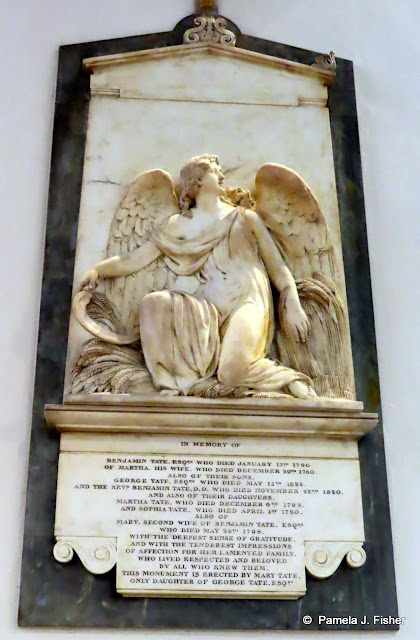 |
| Memorial to members of the Tate family by Sir Richard Westmacott RA in the chancel of All Saints’ church |
The inscription remembers ‘with the deepest sense of gratitude and with the tenderest impressions’, her grandfather Benjamin Tate (died 13 January 1790), his wife Martha (died 29 December 1760), their four children who reached adulthood, George (Mary’s father, died 15 May 1822), the Rev. Dr Benjamin (died 22 November 1820), Martha (died 6 December 1793) and Sophia (died 1 April 1780), and also Mary, Benjamin’s second wife, who had inherited Burleigh from her parents (died 24 May 1798).
A series of letters written by ‘our’ Mary Tate survives from 1844–5, when she was dividing her time between three properties, Burleigh Hall, Grosvenor Place in London and Langdown House in Hampshire. Her time in Leicestershire had been sufficient for her to become well acquainted with William Herrick of Beaumanor Hall and his family, and she turned to him for advice in the 1840s. She was then managing a large estate, and appears to have been doing so very capably, but as a woman she probably faced discrimination in some of her dealings, and he may have provided support on business and legal matters.
Mary extended the Burleigh estate a little by purchasing a neighbouring piece of land, and also improved her estate in Fawley, Hampshire by exchanging with Southampton Corporation parcels of land in other parts of Hampshire for land in Fawley. The latter suggests astute land management and confidence in her business dealings.
Mary was a devout Anglican, and spent large sums in charitable works and the establishment of new churches. In Mitcham, she demolished the property she had inherited from her uncle and built almshouses for 12 poor women on the site, which opened in 1829. In Dibden, near her Hampshire home, she gave money to a school for poor children. Her closest affections seem to have been for Loughborough and the neighbourhood of Burleigh, where the majority of her philanthropy was directed, and especially from the 1830s in Emmanuel parish, Loughborough and Thorpe Acre.
She began an infant school In Loughborough in a building in the yard of the Boot Inn, Fishpool Head (later known as Cattle Market) and by 1836 had rented two other buildings from John Paget, also for use as infant schools, which in that year were teaching 180 boys and 100 girls. These would have been a huge boon to the town, helping married women to obtain work, for example in the local hosiery industry. After Loughborough’s rector, the Rev. William Holme, built a boys’ school at Wards End attached to the new church of Emmanuel, Mary Tate built a girls’ school for Emmanuel on Bedford Square (the building survives as part of the retailer Bed City), endowed it with income of £54 annually towards the payment of salaries and other expenses, and gave a further endowment worth £30 annually to Emmanuel boys’ school.
 |
| The former Emmanuel Girls’ school on Bedford Square |
She gave £500 towards the building of Emmanuel church, alongside £1,000 from the Rev. William Holme and £1,000 from Emmanuel College, Cambridge (patron of All Saints’ church and soon-to-be patron of Emmanuel church). These donations were sufficient to leverage £2,143 from the Commissioners for the Building of New Churches and £500 from the Incorporated Society for Promoting the Enlargement, Building and Repairing of Churches and Chapels, which together enabled Thomas Rickman to be commissioned to design the church, and Rickman’s favoured contractor, John Bennett of Birmingham, to be employed in building it. Emmanuel Church opened in 1837.
 |
| Emmanuel Church on Forest Road, built 1835–7 |
The comment that opened this post, by the Bishop of Peterborough in 1849 (Leicestershire was then within Peterborough diocese), relates to the building and endowment of Thorpe Acre church and its ministry. Thorpe Acre was then a small rural village with a population of 298 in 1841 (it is close to 20,000 today). There was no church in the village, but there was a weekly Sunday service in the medieval chapel at Dishley, a much smaller village c.¾ mile away. Dishley chapel was a donative – a church that was owned by an individual. In this case it had originally belonged to Garendon abbey and had passed into lay hands at the dissolution of the monasteries. Donative churches lay outside ecclesiastical jurisdiction: the family of the owner could choose and pay a minster, and refuse entry to anyone. Dishley chapel was the property of Charles March Phillipps of Garendon, and weekly Sunday services there were conducted by his brother, the Rev. Edward Thomas March Phillipps, vicar of Hathern. A copy of a printed circular now held in Lambeth Palace library shows that there were concerns in the early 1840s for the continuation of Anglican worship in Dishley chapel over the long term as Ambrose March Phillipps, the eldest son and heir of its owner, had converted to Roman Catholicism and was ‘full of zeal for the faith’ (he was employing a priest who was trying to convert local people). The ‘solution’ suggested, and supported by the Rev. E.T.M. Phillipps, was to build an Anglican church in Thorpe Acre, with its own minister.
An appeal was launched for funds to buy land, build a church and parsonage house in Thorpe Acre and provide an income for an incumbent. One account says Miss Tate was the principal donor towards the building of the church, but the amount she gave is not recorded. She donated £1,000 to the Ecclesiastical Commissioners towards an endowment to provide a minister’s salary, gave £500 for the parsonage house and established a fund for church repairs. Her £1,000 gift was the statutory sum that would enable Mary and her heirs to nominate the vicar at each vacancy, but she realised that this sum was insufficient to provide a decent clerical living, and that it could be bolstered by funds from the Ecclesiastical Commissioners at no extra cost to herself if she agreed that the incumbents would always be chosen by some ‘public body’. She therefore specified that the advowson (the right to nominate the minister) was to rest with the bishop of the diocese, but at the same time made a private agreement with the Bishop of Peterborough that she could choose the first appointee. It seems that her first, and possibly second, choice declined the appointment, but the Rev. John Bridges Ottley, a Fellow of Oriel College, Oxford accepted the position. Mary had met him 20 years before, when he was a curate at Dibden (Hampshire).
With a minister in place, Mary consulted him on the location of the parsonage, agreed an alternative site when he rejected the land already purchased for this purpose, and arranged for him to brief the church architect, William Railton, on the specification of the house he wanted. Ottley had a wife and daughter, servants and a private pupil who was boarding with the family, and a large house with three reception rooms and seven bedrooms was built. (This house has since been demolished and replaced by a smaller vicarage on a new site.) Mary Tate also told the bishop in confidence that she would ensure Mr Ottley received a stipend of £150 p.a., although she would not provide an endowment to pay that sum until the Ecclesiastical Commissioners (who then had no funds for augmenting livings) had added to the £1,000 she had already provided. To this end she set up a separate trust, endowing it with bank stock that would provide £120 annually above the sum that her endowment to the Ecclesiastical Commissioners would provide.
Thorpe Acre church was consecrated and opened on 30 September 1845.
Other less prominent acts of philanthropy, of no less importance to the beneficiaries, included weekly gifts of meat to 200 poor families each winter and setting up ‘an establishment in which young women were taught washing’, helping them to earn money to lift them out of poverty.
Mary Tate died at Burleigh Hall on 15 March 1849, aged 73, the last of this Tate lineage. In accordance with her wishes, her body was taken to Mitcham, where she was buried on 22 March. Her charitable wishes continued to the end, with bequests in her will of £500 to each of four medical establishments, including Loughborough Dispensary and Leicester Infirmary. She also left £200 to the Rev. Ottley, the first incumbent of All Saints’ church, Thorpe Acre. Burleigh House passed under the terms of George Tate’s will to a cousin, Louisa Pinfold, who took the surname Tate, as George had desired. Louisa Pinfold Tate gave stained glass for the east window of Emmanuel church in 1851 in memory of Mary.
Before her death, Mary had settled her properties in Surrey on her half-brother Richard Moore (her mother’s son by Bridget’s first marriage to Blunsden Moore). By her will she left Langdown House to one of Richard’s children, Charlotte Selina Hobart (née Moore) and £30,000 to be divided equally between three other children of Richard, Mary Bridget, Mary Jane and Edmund. She does not appear to have been close to her cousin Louisa, as to raise the cash to settle her many personal bequests she instructed her executors to sell the land she had purchased on the edge of the Burleigh Estate, after giving Louisa the option of buying it before it went on the market.
Mary Tate has largely been forgotten today, yet she was a remarkable woman, especially for her time, and one of Loughborough’s and Thorpe Acre’s major benefactors.
Pamela J Fisher
____________________________________
Sources
Primary Sources
The National Archives, letter of wishes for Benjamin Tate (PROB
11/1190/8); wills for Edward Butler (father of Mary Herbert, PROB/ 11/742/486);
the Rev. Dr Benjamin Tate (PROB 11/1637/245); George Tate (PROB 11/1658/44);
Henry Tate (PROB 11/588/390); Lucy widow of Henry Tate (PROB 11/591/485); Mary
wife of Benjamin Tate (PROB 11/1309/3); Mary Tate (PROB 11/2093/364); and
others from this family, of less direct relevance to this article; 1851 census
HO 107/2085/373.
Lambeth Palace Library, Emmanuel Church: CBC/7/1/4; ICBS 1701; ICBS
MB7.
Lambeth Palace Library, Thorpe Acre Church: CC/OF/NB19/54;
ECE/7/1/6676/1; ICBS 3319; ICBS MB12; QAB/7/3/F1442.
The Record Office for Leicestershire, Leicester and Rutland: DE884
(deeds Burleigh); DG9/2249 (Letters re Burleigh and Thorpe Acre); DG9/2556/1–39
(letters re Thorpe Acre church).
Parish registers (through FindMyPast), St George, Hanover Square;
Mitcham, and others.
Commissioners for Building New Churches, Annual Reports, 1836,
1837
J.H.
Chapman, The Register Book of Marriages belonging to the parish of St George
Hanover Square in the County of Middlesex (Harleian Society, London, 1886).
Newspapers
(through British Newspaper Archive)
Hampshire Advertiser, 29 Nov.
1834.
Leic. Jnl. 17 Oct. 1845; 16 Jan. 1852.
Leics Merc., 24 Mar. 1849.
Northampton Merc., 4 Oct.
1845.
Nottingham Review, 4 Mar.
1836; 3 Oct. 1845.
Secondary Sources
N. Pevsner (rev. E. Williamson), Buildings of England: Leics and
Rutl.
M.H. Port, Six Hundred New Churches: The Church Building Commission,
1818–1856 (Reading, 2006)
VCH Hants.
IV, Dibden
VCH Leics.
III, Table of population
White, Hist., Gaz. and Dir. of Leics. and Rutl. (Sheffield,
1863)
Websites
(all accessed 17 July 2023)
http://research.hgt.org.uk/item/langdown-house/
http://www.speel.me.uk/chlondon/mitchamch.htm
http://www.croydonalmshouses.org.uk/our-history.html
____________________________________
About Pamela Fisher
Dr Pamela Fisher works with Leicestershire Victoria County History Trust and is currently researching a social and cultural history of Loughborough since 1750. This will include a history of the schools, churches and other places of worship in Loughborough (including Thorpe Acre and Nanpantan) and will be published as a paperback book as part of the national Victoria County History series of books. Other topics and periods will follow, to eventually become a full history of Loughborough from the earliest settlement in the town to the 21st century. You can follow progress on Twitter and Facebook (@LeicsVCHT) or make contact through their website https://leicestershirehistory.co.uk/ to be added to their mailing list for Newsletters and updates.
____________________________________
Posted by lynneaboutloughborough
With apologies for
typos which are all mine!
_______________________________________________
Thank you for reading this blog.
Copyright:
The copyright © of all content on this blog rests with me, or in the case of guest blogposts, with the named Guest Blogger. However, you are welcome to quote passages from any of my posts, with appropriate credit. The correct citation for this looks as follows:
Fisher, Pamela J. (2023). Mary Tate. Available from: https://lynneaboutloughborough.blogspot.com/2023/08/mary-tate.html [Accessed 31 August 2023]
Take down
policy:
I post no pictures that are not my own, unless I have express permission so to do. All text is my own, and not copied from any other information sources, printed or electronic, unless identified and credited as such. If you find I have posted something in contravention of these statements, or if there are photographs of you which you would prefer not to be here, please contact me at the address listed on the About Me page, and I will remove these.
Blog
archive and tags:
If you are viewing this blog in mobile format, you will not be able to easily access the blog archive, or the clickable links to various topics. These can be accessed if you scroll to the bottom of the page, and click 'View Web Version'. Alternatively, there is also a complete list of posts, which when clicked will take you to the page you are interested in.
Searching
the blog:
You can search the blog using the dedicated search box that appears near the top of the blog when viewed in the web version. Alternatively, you can search using your usual search engine (e.g. Bing, Google, DuckDuckGo etc.) by following this example:
site: https://lynneaboutloughborough.blogspot.com/ “Radmoor House”
NOTE – the words you’re actually looking for must be in “” and the first of these must be preceded by a space
Thank you for reading this blog.
Lynne
